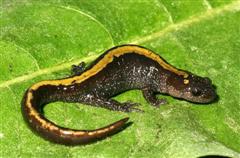salamander - Northern Long Toed
see Eastern Long Toed Salamander Scientific Name: Abystoma macrodactylum krausei
Sat, 23rd November, 2024 - 11:27 am GMT
Sponsor Ads:

Alternative Name
see Eastern Long Toed Salamander Scientific Name: Abystoma macrodactylum krauseiBasic Info
Northern Long Toed Salamanders have a well-defined stripe along their backs that is yellow. This stripe runs from the head to the tail tip. Splotches may also be evident on the head. The background color of this salamander is dark brown or black. Some Northern Long Toed Salamanders may have silver or white spots on the sides of their bodies. The belly is a sooty or dark brown color. There are usually 12 or 13 costal grooves in evidence on the Northern Long Toed Salamander. True to its name, this salamander has long toes. Its body is slender, and it can grow to between 4 and 6.5 inches (10 and 17 centimeters). The snouts of Northern Long Toed Salamanders are blunt, and males have limbs and tails that are noticeably longer than those of females.
Health
Breeding Usually, Northern Long Toed Salamanders breed between January and June. Generally, breeding season is determined more by latitude than by temperature. Northern Long Toed Salamanders undergo amplexus, and then they lay their eggs on submerged vegetation. They may lay the eggs in clusters or singles. The single eggs are generally found closer to the surface, while clusters may be in the deepest area of the water in a protected area such as the underside of a log. Usually, the eggs hatch in about three weeks, and the Northern Long Toed Salamanders will generally remain in the larval state until the summer after they were hatched.Habitat
Northern Long Toed Salamanders are found in a variety of habitats, from scrubland to mountain forests. They may be much more scarce in wooded areas, however. Usually, they live between 1,000 feet and 2,900 meters in elevation.Behavior
Once called the Eastern Long Toed Salamander, the Northern Long Toed Salamander is found in a variety of habitats. With its interesting coloration and long toes, the Northern Long Toed Salamander is a very interesting creature. Northern Long Toed Salamanders are nocturnal. During the day, they can sometimes be found under rocks, logs, or leaves. Some hide underground during the day, although almost all are found near water. At night, they hunt for insects or worms, although some have been known to take tadpoles or small fish. Usually, Northern Long Toed Salamanders remain close to the pool they were hatched in, though some may be found further away. Northern Long Toed Salamanders are not often seen in the wild, and they may be easiest to see when they are migrating toward breeding ponds.Origin
North AmericaHistory
The Northern Long Toed Salamander usually lives in the southern half of the Canadian province of Alberta. They may penetrate into some more northern regions of the United States. In some areas of Canada, they may be considered at risk because their populations are quite patchy, and in some areas they may be rare.Common Foods
feeds primarily on insects, earthworms, small rodents, small animals.Sponsor Ads:
We can't really predict the future at all. All we can do is invent it.
salamander - Northern Long Toed
Coded by: BGID® | ALL RIGHTS RESERVED Copyright © 2000-2024
Disclaimer | Privacy | Report Errors / Contact | Credits








 Politician, US Vice President and President of the USA - Joseph Robinette Biden Jr.
Politician, US Vice President and President of the USA - Joseph Robinette Biden Jr.  President of the United States of America - Real Estate mogul, Pageant owner and now one of the most controversial men in political history.
President of the United States of America - Real Estate mogul, Pageant owner and now one of the most controversial men in political history.  versus
versus  Russia: 'The Evil Empire'? Are they all that bad or is it just the USA trying to portray Russia as bad because they are a world power with land bigger and a society very different from the USA ideal?
Russia: 'The Evil Empire'? Are they all that bad or is it just the USA trying to portray Russia as bad because they are a world power with land bigger and a society very different from the USA ideal?  Global warming has been in and out as the "latest" hot topic for many years. It is, according to modern scientists, the result of man-made industrial pollutants, clearing forested areas, agriculture, etc. But now they are thinking it started way before the Industrial Revolution...
Global warming has been in and out as the "latest" hot topic for many years. It is, according to modern scientists, the result of man-made industrial pollutants, clearing forested areas, agriculture, etc. But now they are thinking it started way before the Industrial Revolution... 
 Corona virus
Corona virus 
 Users with wide screen monitors can benefit from more content on every page.
Users with wide screen monitors can benefit from more content on every page.